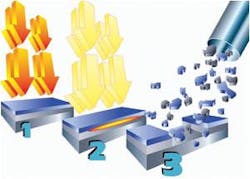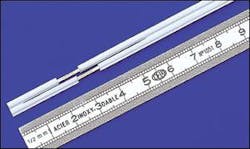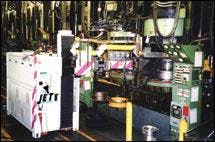Jörg Jetter
While applications for welding, drilling or cutting with lasers have been known for years, laser surface cleaning still is considered a niche technology. The adaptation in industrial cleaning applications did not take place until recently although the process turned out to be capable of removing most organic material effectively.
Today, there is a wide range of pulsed laser cleaning or de–coating systems in use. Laser systems are operated to de–coat paint from delicate surfaces, strip insulation from conductors, engrave surfaces by ablation or remove vulcanizing residue from tire molds. All these operations can be categorized as some type of "cleaning."
Why laser?
The development of laser surface cleaning was influenced by the need for a non–abrasive and non–hazardous cleaning process that is suitable to substitute for the use of chemicals or abrasive blasting systems.
One key problem related to most of the conventional cleaning technologies is the wear of the substrate and the negative environmental impact. Abrasive blasting damages delicate surfaces and creates significant amounts of waste. Using chemical solvents involves liquid waste and potentially hazardous vapors. Such problems led to the development of the first laser systems for this purpose.
The laser's advantages for surface cleaning include the following: the non-contact/non-abrasive process, no use of chemicals or blasting media, a reduction in the amount of waste, automation and safety.
How laser cleaning works
Nearly all industrial laser cleaning applications are based on pulsed laser radiation, although laser output power, wavelengths and pulse parameters may differ substantially. The basic principle is similar.
An extremely brief laser pulse (in the µs–ms range), with a power of several million watts, is aimed at the surface to be removed.
The energy applied to the top layer cannot dissipate and blasts off the material.
While part of the removed material is vaporized, the remainder may be suctioned away as particle dust and collected in a filtration system.
This process is repeated until the desired ablation depth has been reached. The laser light is absorbed only by organic material, such as paint, insulation or rubber. Therefore the non–organic substrate is not being affected by the cleaning. Metal surfaces, such as a tire mold or a copper conductor, reflect the laser beam. There is no mechanical, thermal or chemical strain on the substrate (see Figure 1).
The ablation depth can be controlled within 5–10 µm, so it is possible to selectively remove coatings. This is especially important if only parts of a multi–layer paint system are to be removed, for instance only the topcoat and not the primer.
There is a broad range of pulsed lasers, including pulsed Nd:YAG, CO2 and diode laser sources, available. For surface cleaning, pulsed CO2–TEA lasers proved to be efficient and, until now, most laser cleaning systems still utilize this laser.
Applications and economics
One can distinguish between micro–, macro– and large–scale applications when looking at laser surface cleaning. As a basic rule of thumb, it is fair to say that the investment cost is driven by the required laser power and thus influenced by the required cleaning volume and process speeds. Depending on how much material needs to be removed, the investment value of laser systems will differ.
Micro applications
In the electronics industry there is a need to clean contact areas to allow the welding or soldering of plugs, pads or similar connectors. The insulation of delicate cables, such as foil insulated flat wiring, can be removed efficiently without harming the copper conductor. Unlike mechanical stripping processes, the laser can even strip insulation from a 1–µm tin or silver coating on the conductor, without affecting this anti–corrosion layer. Laser systems allow the application of windows and thin cuts to flat wires, printed circuits and similar components with high precision and with a higher flexibility than mechanical stripping (see Figure 2).
Automobile brake or cooling–lines are coated with different polyamid layers to protect them from corrosion and wear. To install plugs, the coating needs to be removed at the end of the tubes. Laser systems can effectively remove the coating without harming the soft aluminium core beneath.
For these applications the investment costs start from $150,000 and reach process speeds in the part/second range, depending on the material and volume of the surface layer to be removed.
Macro applications
In the rubber and tire industry there is a need to clean molds after several hundred parts are cured. The molds that are installed in curing presses need to be removed, dismantled and cleaned by blasting or chemical solvents, a time–consuming process that tends to damage the expensive tooling. Cleaning a tire mold for passenger cars takes eight hours of machine down–time and the same amount of manual labor time. The use of laser enables molds to be cleaned in the hot curing press without dismantling them and without causing any mold abrasion. Mobile laser systems can clean a 9–ft2 surface tire mold within 45–60 minutes, creating substantial savings (see Figure 3).
Standard mold cleaners for the tire industry are used by five of the top ten makers and each has an investment value of approximately $500,000.
Other macro applications include mobile, semi–automated laser strippers that can be used to remove paint from aerospace components and railcars, or marking systems that ablate material in order to make a logo or imprint visible.
Large–scale surface cleaning
In the early 1990s, commercial and military aircraft frequently needed to be paint stripped to allow for the D–check inspection and other maintenance work. With increasing legal restrictions for using chemical solvents, the laser apparently offered a potential alternative. Related to this application were investigations of laser stripping lead–based paint from buildings, bridges or ships.
Numerous research projects within the industry and government–funded institutes have produced ambiguous results. Today, only a few industrial laser systems are in use to strip paint from aircraft or helicopter components, which proves the potential of the technology. The step to stripping complete aircraft, railcars or buildings has not been made yet.
Fully automated work cell systems utilizing multi–kilowatt lasers are now being used, with an investment value of $1–2 million, and reaching stripping rates of 100–200 ft2/hour. Higher stripping rates at more affordable cost will be possible in the future, but this will likely utilize laser sources other than the TEA.
Machines
Laser systems for surface cleaning are rarely off–the–shelf products, with the design differing with the size and type of the parts to be stripped. Key to the machine design is the beam guidance from the laser source to the surface to be cleaned. In some applications, the laser beam is scanned over the fixed workpiece (i.e. tire mold cleaning, paint stripping), while in other applications the parts are being transported under a stationary laser source (cable stripping).
Jörg Jetter is manager marketing and sales of JET Lasersystems GmbH (Huckelhover, Germany). He can be contacted by Tel. at +49 (0) 24339754–0 or via e–mail at [email protected].


